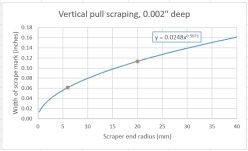This lathe has been an ongoing project for me, I enjoy the challenge of measuring things and then trying to understand and make equations that predict those measurements and using the equations to refine what the next step will be. This is in my mind, the definition of engineering. No question in my mind it is possible for a skilled person to get the same results quicker without doing this. The bed of the lathe has been planned. The headstock is currently out of alignment by about 0.003" at the end of a 12" test bar. I was thinking about glueing on some more rulon on the bottom of it because it is so nice to scrape but will probably scrape the bottom of the head. Perhaps I should check the height of the tailstock, If I remember correctly, the Connelly book says do the tailstock before the headstock.
I have several posts on this forum asking questions and getting advice on earlier parts of this project. I am not sure if this is better than one really long post lasting years for the entire project.
Funny comment about candles and lanterns, it reminded me exploring caves in my youth, we used carbide lights, they were lighter than the battery powered lights of the day, I imagine all the kids these days have newfangled LED lights. This is just a little off topic...
You could probably guess I am a retired mechanical engineer.










